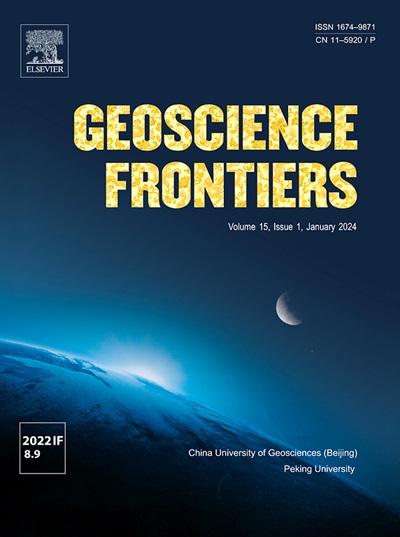岩浆初始水和饱和水阈值决定了铜禀赋:磷灰石F-Cl-OH成分的启示
IF 8.9
1区 地球科学
Q1 GEOSCIENCES, MULTIDISCIPLINARY
引用次数: 0
摘要
岩浆挥发物(H2O、F、Cl),尤其是水,对斑岩铜矿床的形成至关重要,因为它是金属的重要载体。然而,准确量化深部成矿岩浆的含水量仍然是一项挑战。在此,我们采用磷灰石和前向建模方法重建岩浆水演化历史,特别关注岩浆初始 H2O 含量和水饱和阈值对斑岩成矿作用的控制。调查的样本包括花岗岩和来自铜矿化程度高和贫瘠地区的磷灰石。总体而言,我们的研究表明,与矿石有关的岩浆系统和贫矿岩浆系统都是含水岩浆系统,无论是否成矿,不同岩浆系统的模型岩浆含水量都有很大差异,主要区别在于水饱和阈值(贫矿为 6.0 wt.%,高度成矿可达 10.0 wt.%)。结合全岩地球化学数据(K2O 和 Sr/Y 含量高)和建模结果(建模水阈值高),我们认为与矿石有关的岩浆储藏在更深的地方,水溶性更高。总之,我们认为岩浆水饱和度在斑岩铜系统的形成过程中起着至关重要的作用。肥沃岩浆具有较高的水溶性,而较深的储藏深度是一个关键因素,饱和后可显著富水。本文章由计算机程序翻译,如有差异,请以英文原文为准。

Magmatic initial and saturated water thresholds determine copper endowments: Insights from apatite F-Cl-OH compositions
Magmatic volatiles (H2O, F, Cl), especially water, are critical in the formation of porphyry copper deposit, for its significance as a carrier for metals. However, accurately quantifying the water contents of deep ore-forming magma remain a challenge. Here, we used apatite and forward modelling methods to reconstruct magmatic water evolution histories, with special concern on the control of initial magmatic H2O contents and water saturation threshold to porphyry mineralization. Samples investigated include granitoid rocks and apatite from highly copper-mineralized and barren localities. Generally, our research suggested that both ore-related and ore-barren magma systems are hydrous, the modeled magmatic water contents vary significantly among systems whether mineralized or not, and the major difference lies in the threshold of water saturation (6.0 wt.% for barren, and up to 10.0 wt.% for highly mineralized). Combined with whole rock geochemistry data (high K2O and Sr/Y contents) and modeling result (high modeled water thresholds), we think the ore-related magmas are stored at deeper depth with higher water solubility. In conclusion, we propose that the level of magmatic water saturation plays a crucial role in the formation of porphyry copper systems. Fertile magma has higher water solubility to which deeper storage depth is a critical contributing factor, and can get significantly water enriched upon saturation.
求助全文
通过发布文献求助,成功后即可免费获取论文全文。
去求助
来源期刊

Geoscience frontiers
Earth and Planetary Sciences-General Earth and Planetary Sciences
CiteScore
17.80
自引率
3.40%
发文量
147
审稿时长
35 days
期刊介绍:
Geoscience Frontiers (GSF) is the Journal of China University of Geosciences (Beijing) and Peking University. It publishes peer-reviewed research articles and reviews in interdisciplinary fields of Earth and Planetary Sciences. GSF covers various research areas including petrology and geochemistry, lithospheric architecture and mantle dynamics, global tectonics, economic geology and fuel exploration, geophysics, stratigraphy and paleontology, environmental and engineering geology, astrogeology, and the nexus of resources-energy-emissions-climate under Sustainable Development Goals. The journal aims to bridge innovative, provocative, and challenging concepts and models in these fields, providing insights on correlations and evolution.
 求助内容:
求助内容: 应助结果提醒方式:
应助结果提醒方式:


